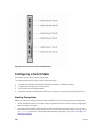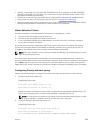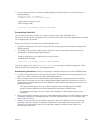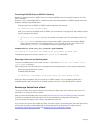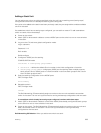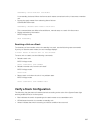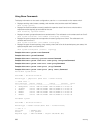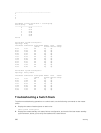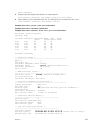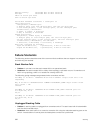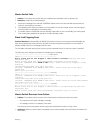
• If the new unit has been configured with a stack number that is already assigned to a stack member,
the stack avoids a numbering conflict by assigning the new switch the first available stack number.
• If the stack has been provisioned for the stack number that is assigned to the new unit, the pre-
configured provisioning must match the switch type. If there is a conflict between the provisioned
switch type and the new unit, a mismatch error message displays.
Merging Two Stacks
You can merge two MXL 10/40GbE Switch stacks while they are powered and online.
To merge two stacks, connect one stack to the other with 40G QSFP or direct attach cables. After you
connect the stacking cables, a merge of the two stacks is performed:
• The Dell Networking OS selects a master switch for the merged stack from the existing masters in the
two stacks. To ensure that one of the two master switches wins the master election in the merged
stack, use the stack-unit priority command to configure the highest priority for the unit (refer
to
Assigning a Priority to Stacked Switches).
• All the units in the losing stack go for a reboot and then merge with the winning stack that has the
stack master.
• If there is no unit numbering conflict, the stack members retain their previous unit numbers.
Otherwise, the stack master assigns new unit numbers, based on the order in which they come
online.
• The new stack master uses its own startup and running configurations to synchronize the
configurations on the new stack members.
NOTE: Adding a new unit that is powered on and has stack groups configured is the same as
merging two stacks (refer to Adding a Stack Unit). If the new unit has been configured with a higher
priority than the current stack master, it becomes the new stack master and the stack reloads. If the
new unit does not have a higher priority than the master switch, it is added as a member switch.
Splitting a Stack
To split an MXL 10/40GbE switch stack, unplug the stacking cables between member units at any time:
while the stack is powered on or off and when the units are online or offline.
Each portion of the split stack retains the startup and running configuration of the original stack.
For a stack that is split into two smaller stacks, each with multiple units:
• If one of the new stacks receives the master and the standby units, it is unaffected by the split.
• If one of the new stacks receives only the master unit, the master switch retains its role and a new
standby is elected.
• If one of the new stacks receives only the standby unit, it becomes the master in the new stack and
the Dell Networking OS elects a new standby.
• If one of the new stacks receives neither the master nor the standby unit, the stack is reset so that a
new election takes place.
Managing Redundant Stack Management
To manage the redundancy behavior in a stack, use the following redundancy commands.
• Reset the current stack master and make the standby unit the new master.
EXEC Privilege mode
896
Stacking



